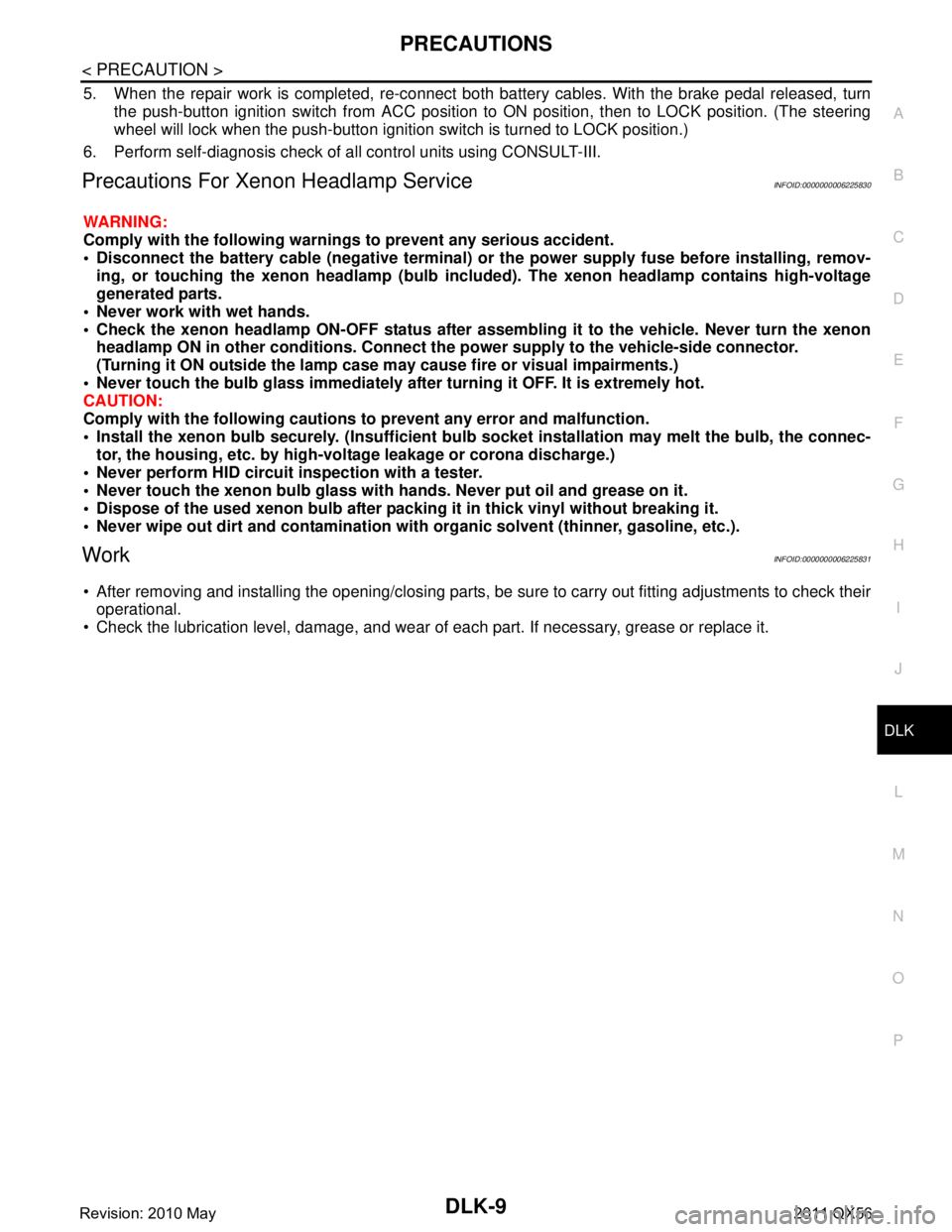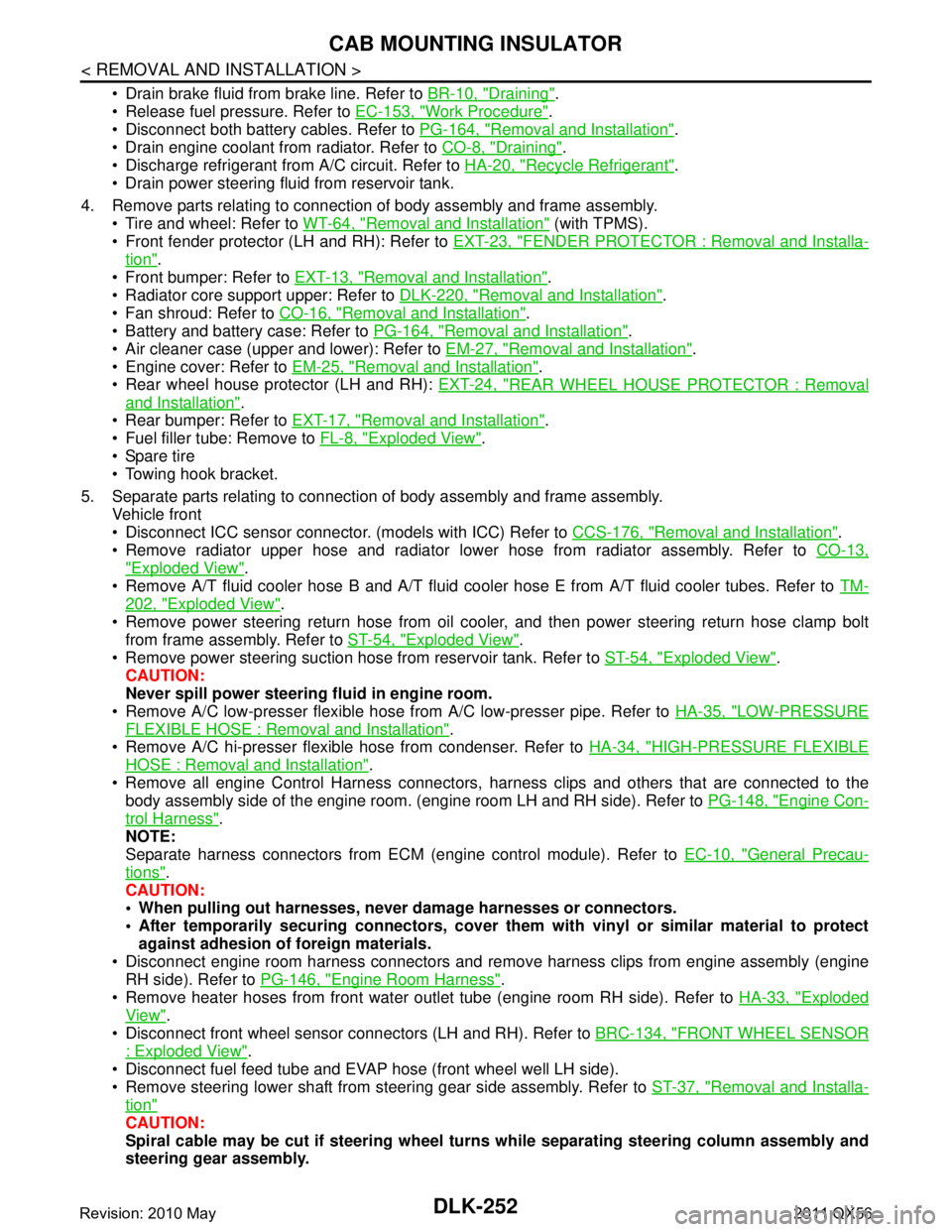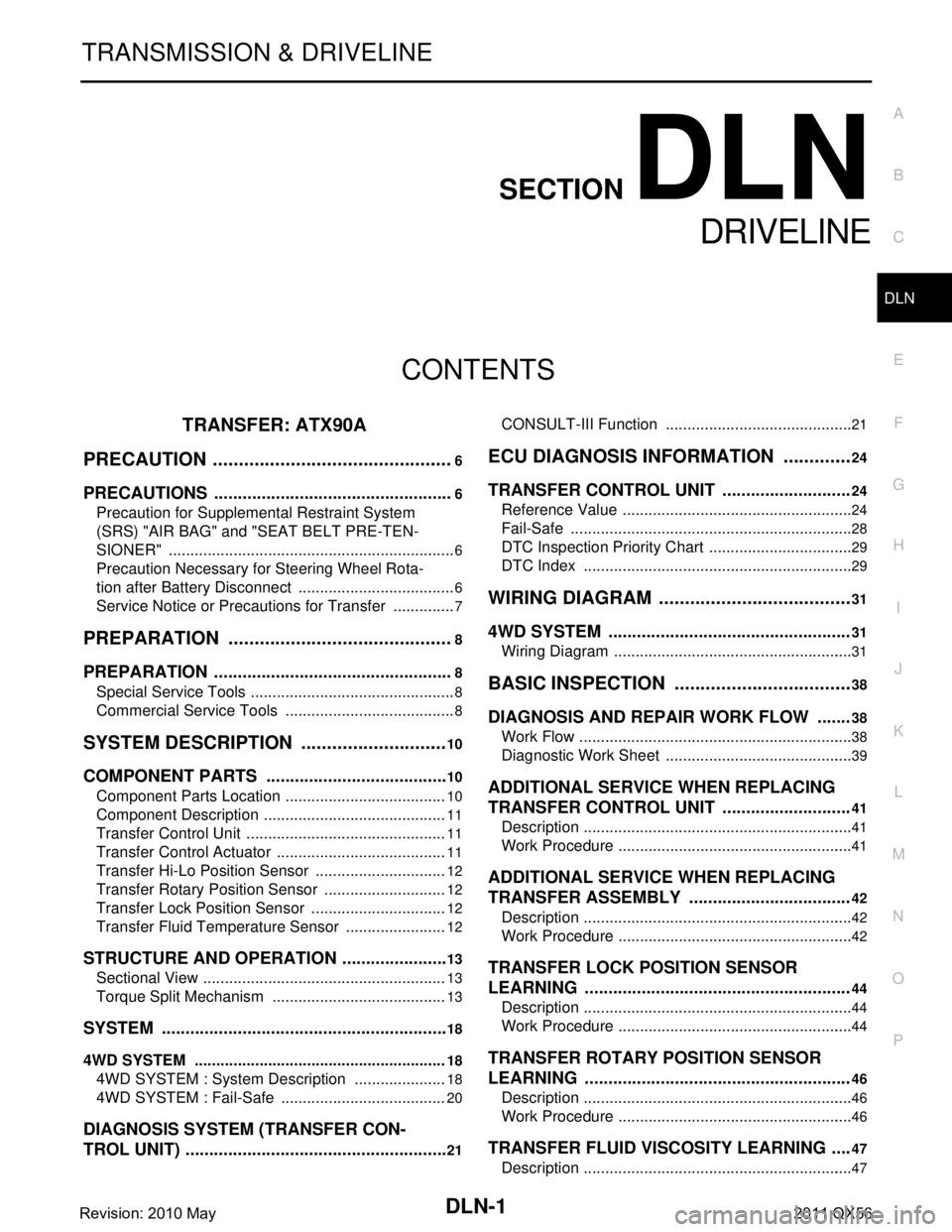2011 INFINITI QX56 steering wheel
[x] Cancel search: steering wheelPage 1545 of 5598

PRECAUTIONSDLK-9
< PRECAUTION >
C
DE
F
G H
I
J
L
M A
B
DLK
N
O P
5. When the repair work is completed, re-connect both battery cables. With the brake pedal released, turn
the push-button ignition switch from ACC position to ON position, then to LOCK position. (The steering
wheel will lock when the push-button ignition switch is turned to LOCK position.)
6. Perform self-diagnosis check of a ll control units using CONSULT-III.
Precautions For Xenon Headlamp ServiceINFOID:0000000006225830
WARNING:
Comply with the follow ing warnings to prevent any serious accident.
Disconnect the battery cable (neg ative terminal) or the power supply fuse before installing, remov-
ing, or touching the xenon headlamp (bulb included). The xenon headlamp contains high-voltage
generated parts.
Never work with wet hands.
Check the xenon headlamp ON-OFF status after assem bling it to the vehicle. Never turn the xenon
headlamp ON in other conditions. Connect th e power supply to the vehicle-side connector.
(Turning it ON outside the lamp case m ay cause fire or visual impairments.)
Never touch the bulb glass immediately afte r turning it OFF. It is extremely hot.
CAUTION:
Comply with the follow ing cautions to prevent an y error and malfunction.
Install the xenon bulb securely. (I nsufficient bulb socket installation may melt the bulb, the connec-
tor, the housing, etc. by high-vol tage leakage or corona discharge.)
Never perform HID circuit inspection with a tester.
Never touch the xenon bulb glass with ha nds. Never put oil and grease on it.
Dispose of the used xenon bulb after p acking it in thick vinyl without breaking it.
Never wipe out dirt and cont amination with organic solven t (thinner, gasoline, etc.).
WorkINFOID:0000000006225831
After removing and installing the opening/closing parts, be sure to carry out fitting adjustments to check their
operational.
Check the lubrication level, damage, and wear of each part. If necessary, grease or replace it.
Revision: 2010 May2011 QX56
Page 1788 of 5598

DLK-252
< REMOVAL AND INSTALLATION >
CAB MOUNTING INSULATOR
Drain brake fluid from brake line. Refer to BR-10, "Draining".
Release fuel pressure. Refer to EC-153, "
Work Procedure".
Disconnect both battery cables. Refer to PG-164, "
Removal and Installation".
Drain engine coolant from radiator. Refer to CO-8, "
Draining".
Discharge refrigerant from A/C circuit. Refer to HA-20, "
Recycle Refrigerant".
Drain power steering fluid from reservoir tank.
4. Remove parts relating to connection of body assembly and frame assembly. Tire and wheel: Refer to WT-64, "
Removal and Installation" (with TPMS).
Front fender protector (LH and RH): Refer to EXT-23, "
FENDER PROTECTOR : Removal and Installa-
tion".
Front bumper: Refer to EXT-13, "
Removal and Installation".
Radiator core support upper: Refer to DLK-220, "
Removal and Installation".
Fan shroud: Refer to CO-16, "
Removal and Installation".
Battery and battery case: Refer to PG-164, "
Removal and Installation".
Air cleaner case (upper and lower): Refer to EM-27, "
Removal and Installation".
Engine cover: Refer to EM-25, "
Removal and Installation".
Rear wheel house protector (LH and RH): EXT-24, "
REAR WHEEL HOUSE PROTECTOR : Removal
and Installation".
Rear bumper: Refer to EXT-17, "
Removal and Installation".
Fuel filler tube: Remove to FL-8, "
Exploded View".
Spare tire
Towing hook bracket.
5. Separate parts relating to connection of body assembly and frame assembly. Vehicle front
Disconnect ICC sensor connector. (models with ICC) Refer to CCS-176, "
Removal and Installation".
Remove radiator upper hose and radiator lower hose from radiator assembly. Refer to CO-13,
"Exploded View".
Remove A/T fluid cooler hose B and A/T fluid cooler hose E from A/T fluid cooler tubes. Refer to TM-
202, "Exploded View".
Remove power steering return hose from oil cooler, and then power steering return hose clamp bolt from frame assembly. Refer to ST-54, "
Exploded View".
Remove power steering suction hose from reservoir tank. Refer to ST-54, "
Exploded View".
CAUTION:
Never spill power steering fluid in engine room.
Remove A/C low-presser flexible hose from A/C low-presser pipe. Refer to HA-35, "
LOW-PRESSURE
FLEXIBLE HOSE : Removal and Installation".
Remove A/C hi-presser flexible hose from condenser. Refer to HA-34, "
HIGH-PRESSURE FLEXIBLE
HOSE : Removal and Installation".
Remove all engine Control Harness connectors, har ness clips and others that are connected to the
body assembly side of the engine room. (engine room LH and RH side). Refer to PG-148, "
Engine Con-
trol Harness".
NOTE:
Separate harness connectors from ECM (engine control module). Refer to EC-10, "
General Precau-
tions".
CAUTION:
When pulling out harnesses, never damage harnesses or connectors.
After temporarily securing connectors, cover th em with vinyl or similar material to protect
against adhesion of foreign materials.
Disconnect engine room harness connectors and remo ve harness clips from engine assembly (engine
RH side). Refer to PG-146, "
Engine Room Harness".
Remove heater hoses from front water outlet tube (engine room RH side). Refer to HA-33, "
Exploded
View".
Disconnect front wheel sensor connectors (LH and RH). Refer to BRC-134, "
FRONT WHEEL SENSOR
: Exploded View".
Disconnect fuel feed tube and EVAP hos e (front wheel well LH side).
Remove steering lower shaft from steering gear side assembly. Refer to ST-37, "
Removal and Installa-
tion"
CAUTION:
Spiral cable may be cut if steering wheel turns while separating steering column assembly and
steering gear assembly.
Revision: 2010 May2011 QX56
Page 1803 of 5598

DLN-1
TRANSMISSION & DRIVELINE
CEF
G H
I
J
K L
M
SECTION DLN
A
B
DLN
N
O P
CONTENTS
DRIVELINE
TRANSFER: ATX90A
PRECAUTION ................ ...............................
6
PRECAUTIONS .............................................. .....6
Precaution for Supplemental Restraint System
(SRS) "AIR BAG" and "SEAT BELT PRE-TEN-
SIONER" ............................................................. ......
6
Precaution Necessary for Steering Wheel Rota-
tion after Battery Disconnect .....................................
6
Service Notice or Precautions for Transfer ...............7
PREPARATION ............................................8
PREPARATION .............................................. .....8
Special Service Tools .......................................... ......8
Commercial Service Tools ........................................8
SYSTEM DESCRIPTION .............................10
COMPONENT PARTS ................................... ....10
Component Parts Location .................................. ....10
Component Description ...........................................11
Transfer Control Unit ...............................................11
Transfer Control Actuator ........................................11
Transfer Hi-Lo Position Sensor ...............................12
Transfer Rotary Position Sensor .............................12
Transfer Lock Position Sensor ................................12
Transfer Fluid Temperature Sensor ........................12
STRUCTURE AND OPERATION .......................13
Sectional View ..................................................... ....13
Torque Split Mechanism .........................................13
SYSTEM .............................................................18
4WD SYSTEM ...........................................................18
4WD SYSTEM : System De scription ......................18
4WD SYSTEM : Fail-Safe ......................... ..............20
DIAGNOSIS SYSTEM (TRANSFER CON-
TROL UNIT) .................................................... ....
21
CONSULT-III Function ........................................ ....21
ECU DIAGNOSIS INFORMATION ..............24
TRANSFER CONTROL UNIT ...........................24
Reference Value .................................................. ....24
Fail-Safe ..................................................................28
DTC Inspection Priority Chart ..................................29
DTC Index ...............................................................29
WIRING DIAGRAM ......................................31
4WD SYSTEM .. ................................ .................31
Wiring Diagram .................................................... ....31
BASIC INSPECTION ...................................38
DIAGNOSIS AND REPAIR WORK FLOW .......38
Work Flow ............................................................ ....38
Diagnostic Work Sheet ............................................39
ADDITIONAL SERVICE WHEN REPLACING
TRANSFER CONTROL UNIT ...........................
41
Description ...............................................................41
Work Procedure .......................................................41
ADDITIONAL SERVICE WHEN REPLACING
TRANSFER ASSEMBLY ..................................
42
Description ...............................................................42
Work Procedure .......................................................42
TRANSFER LOCK POSITION SENSOR
LEARNING ....................................... .................
44
Description ........................................................... ....44
Work Procedure .......................................................44
TRANSFER ROTARY POSITION SENSOR
LEARNING ....................................... .................
46
Description ........................................................... ....46
Work Procedure .......................................................46
TRANSFER FLUID VISCOSITY LEARNING ....47
Description ...............................................................47
Revision: 2010 May2011 QX56
Page 1804 of 5598

DLN-2
Work Procedure ......................................................47
CONFIGURATION (TRANSFER CONTROL
UNIT) ..................................................................
48
Description ........................................................... ...48
Work Procedure ......................................................48
DTC/CIRCUIT DIAGNOSIS ...................... ...51
P1802, P1803, P1804, P1809 TRANSFER
CONTROL UNIT ............................................. ...
51
DTC Logic ............................................................ ...51
Diagnosis Procedure ..............................................51
P1807 OUT PUT SHAFT SPEED SENSOR ......52
DTC Logic ............................................................ ...52
Diagnosis Procedure ..............................................52
P1808 WHEEL SPEED SENSOR ......................53
DTC Logic ............................................................ ...53
Diagnosis Procedure ..............................................53
P180C SENSOR POWER SUPPLY (5V) ..........54
Description ........................................................... ...54
DTC Logic ...............................................................54
Diagnosis Procedure ..............................................54
P180D TRANSFER ROTARY POSITION
SENSOR ............................................................
57
DTC Logic ............................................................ ...57
Diagnosis Procedure ..............................................57
P180E SENSOR POWER SUPPLY (8V) ...........59
Description ........................................................... ...59
DTC Logic ...............................................................59
Diagnosis Procedure ..............................................59
P180F TRANSFER INTERNAL SPEED SEN-
SOR ....................................................................
61
DTC Logic ............................................................ ...61
Diagnosis Procedure ..............................................61
P1811 POWER SUPPLY CIRCUIT FOR
TRANSFER CONTROL UNIT ............................
64
Description ........................................................... ...64
DTC Logic ...............................................................64
Diagnosis Procedure ..............................................64
P1813 4WD MODE SWITCH .............................67
DTC Logic ............................................................ ...67
Diagnosis Procedure ..............................................67
Component Inspection ............................................68
P1816 PARKING/NEUTRAL POSITION
SWITCH .............................................................
69
DTC Logic ............................................................ ...69
Diagnosis Procedure ..............................................69
P1817 TRANSFER MOTOR ..............................70
DTC Logic ............................................................ ...70
Diagnosis Procedure ..............................................70
Component Inspection ......................................... ...71
P181A TRANSFER MOTOR TEMPERATURE
SENSOR ............................................................
72
DTC Logic ............................................................ ...72
Diagnosis Procedure ...............................................72
Component Inspection ............................................73
P181B INCOMPLETE SELFSHUT ....................74
DTC Logic ............................................................ ...74
Diagnosis Procedure ...............................................74
P181C TRANSFER MOTOR POWER SUP-
PLY ....................................................................
76
Description ........................................................... ...76
DTC Logic ...............................................................76
Diagnosis Procedure ...............................................76
P181E STEERING ANGLE SENSOR ...............77
DTC Logic ............................................................ ...77
Diagnosis Procedure ...............................................77
P181F INCOMPLETE CALIBRATION ..............78
DTC Logic ............................................................ ...78
Diagnosis Procedure ...............................................78
P1820 ENGINE SPEED SIGNAL ......................79
DTC Logic ............................................................ ...79
Diagnosis Procedure ...............................................79
P1826 TRANSFER FLUID TEMPERATURE ....80
DTC Logic ............................................................ ...80
Diagnosis Procedure ...............................................80
Component Inspection ............................................81
P1829 ACCELERATOR PEDAL POSITION
SENSOR ............................................................
82
DTC Logic ............................................................ ...82
Diagnosis Procedure ...............................................82
P182A TRANSFER HI-LO POSITION SEN-
SOR ...................................................................
83
DTC Logic ............................................................ ...83
Diagnosis Procedure ...............................................83
P182B TRANSFER LOCK POSITION SEN-
SOR ...................................................................
85
DTC Logic ............................................................ ...85
Diagnosis Procedure ...............................................85
P1830 ABS OPERATION SIGNAL ...................88
DTC Logic ............................................................ ...88
Diagnosis Procedure ...............................................88
P1831 VDC OPERATION SIGNAL ...................89
DTC Logic ............................................................ ...89
Diagnosis Procedure ...............................................89
P1832 TCS OPERATION SIGNAL ....................90
DTC Logic ............................................................ ...90
Diagnosis Procedure ...............................................90
Revision: 2010 May2011 QX56
Page 1806 of 5598

DLN-4
Commercial Service Tools .....................................125
SYMPTOM DIAGNOSIS ............................126
NOISE, VIBRATION, AND HARSHNESS
(NVH) TROUBLESHOOTING ......................... .
126
NVH Troubleshooting Chart ................................ ..126
PERIODIC MAINTENANCE ..................... ..127
FRONT PROPELLER SHAFT ........................ .127
Inspection ............................................................ ..127
REMOVAL AND INSTALLATION ..............128
FRONT PROPELLER SHAFT ........................ .128
Exploded View ..................................................... ..128
Removal and Installation .......................................129
Disassembly and Assembly ...................................129
Inspection ..............................................................131
SERVICE DATA AND SPECIFICATIONS
(SDS) .............. ............................................
133
SERVICE DATA AND SPECIFICATIONS
(SDS) ............................................................... .
133
General Specification .......................................... ..133
Propeller Shaft Runout ..........................................133
Journal Axial Play ..................................................133
REAR PROPELLER SHAFT: 2F P26
SYMPTOM DIAGNOSIS .. ..........................
134
NOISE, VIBRATION, AND HARSHNESS
(NVH) TROUBLESHOOTING ......................... .
134
NVH Troubleshooting Chart ................................ ..134
PERIODIC MAINTENANCE ..................... ..135
REAR PROPELLER SHAFT .......................... .135
Inspection ............................................................ ..135
REMOVAL AND INSTALLATION ..............136
REAR PROPELLER SHAFT .......................... .136
Exploded View ..................................................... ..136
Removal and Installation .......................................137
Disassembly and Assembly ...................................137
Inspection ..............................................................139
SERVICE DATA AND SPECIFICATIONS
(SDS) .............. ............................................
140
SERVICE DATA AND SPECIFICATIONS
(SDS) ............................................................... .
140
General Specification .......................................... ..140
Propeller Shaft Runout ..........................................140
Journal Axial Play ..................................................140
REAR PROPELLER SHAFT: 2S1410
SYMPTOM DIAGNOSIS .. ..........................
141
NOISE, VIBRATION, AND HARSHNESS
(NVH) TROUBLESHOOTING ......................... ..
141
NVH Troubleshooting Chart ................................. .141
PERIODIC MAINTENANCE ......................142
REAR PROPELLER SHAFT .......................... ..142
Inspection ............................................................. .142
REMOVAL AND INSTALLATION .............143
REAR PROPELLER SHAFT .......................... ..143
Exploded View ..................................................... .143
Removal and Installation .......................................144
Disassembly and Assembly ..................................144
Inspection ..............................................................146
SERVICE DATA AND SPECIFICATIONS
(SDS) ........ .................................................
147
SERVICE DATA AND SPECIFICATIONS
(SDS) .............................................................. ..
147
General Specification ........................................... .147
Propeller Shaft Runout ..........................................147
Journal Axial Play .................................................147
FRONT FINAL DRIVE: R180A
PRECAUTION ............... ............................
148
PRECAUTIONS .............................................. ..148
Precaution Necessary for Steering Wheel Rota-
tion after Battery Disconnect ................................ .
148
Precaution for Servicing Front Final Drive ............148
PREPARATION .........................................149
PREPARATION .............................................. ..149
Special Service Tool ............................................ .149
Commercial Service Tool ......................................151
SYSTEM DESCRIPTION ..........................153
STRUCTURE AND OPERATION ................... ..153
Sectional View ..................................................... .153
SYMPTOM DIAGNOSIS ...........................154
NOISE, VIBRATION AND HARSHNESS
(NVH) TROUBLESHOOTING ......................... ..
154
NVH Troubleshooting Chart ................................. .154
PERIODIC MAINTENANCE ......................155
FRONT DIFFERENTIAL GEAR OIL .............. ..155
Inspection ............................................................. .155
Draining .................................................................155
Refilling .................................................................155
REMOVAL AND INSTALLATION .............156
FRONT OIL SEAL .......................................... ..156
Exploded View ..................................................... .156
Revision: 2010 May2011 QX56
Page 1808 of 5598
![INFINITI QX56 2011 Factory Service Manual
DLN-6
< PRECAUTION >[TRANSFER: ATX90A]
PRECAUTIONS
PRECAUTION
PRECAUTIONS
Precaution for Supplemental Restraint S
ystem (SRS) "AIR BAG" and "SEAT BELT
PRE-TENSIONER"
INFOID:0000000006222209
The Supp INFINITI QX56 2011 Factory Service Manual
DLN-6
< PRECAUTION >[TRANSFER: ATX90A]
PRECAUTIONS
PRECAUTION
PRECAUTIONS
Precaution for Supplemental Restraint S
ystem (SRS) "AIR BAG" and "SEAT BELT
PRE-TENSIONER"
INFOID:0000000006222209
The Supp](/manual-img/42/57033/w960_57033-1807.png)
DLN-6
< PRECAUTION >[TRANSFER: ATX90A]
PRECAUTIONS
PRECAUTION
PRECAUTIONS
Precaution for Supplemental Restraint S
ystem (SRS) "AIR BAG" and "SEAT BELT
PRE-TENSIONER"
INFOID:0000000006222209
The Supplemental Restraint System such as “A IR BAG” and “SEAT BELT PRE-TENSIONER”, used along
with a front seat belt, helps to reduce the risk or severi ty of injury to the driver and front passenger for certain
types of collision. This system includes seat belt switch inputs and dual stage front air bag modules. The SRS
system uses the seat belt switches to determine the front air bag deployment, and may only deploy one front
air bag, depending on the severity of a collision and w hether the front occupants are belted or unbelted.
Information necessary to service the system safely is included in the “SRS AIR BAG” and “SEAT BELT” of this
Service Manual.
WARNING:
• To avoid rendering the SRS inopera tive, which could increase the risk of personal injury or death in
the event of a collision that would result in air bag inflation, all maintenance must be performed by
an authorized NISS AN/INFINITI dealer.
Improper maintenance, including in correct removal and installation of the SRS, can lead to personal
injury caused by unintent ional activation of the system. For re moval of Spiral Cable and Air Bag
Module, see the “SRS AIR BAG”.
Do not use electrical test equipmen t on any circuit related to the SRS unless instructed to in this
Service Manual. SRS wiring harnesses can be identi fied by yellow and/or orange harnesses or har-
ness connectors.
PRECAUTIONS WHEN USING POWER TOOLS (AIR OR ELECTRIC) AND HAMMERS
WARNING:
When working near the Air Bag Diagnosis Sensor Unit or other Air Bag System sensors with the ignition ON or engine running, DO NOT use air or electric power tools or strike near the sensor(s)
with a hammer. Heavy vibration could activate the sensor(s) and deploy the air bag(s), possibly
causing serious injury.
When using air or electric power tools or hammers , always switch the ignition OFF, disconnect the
battery, and wait at least 3 minu tes before performing any service.
Precaution Necessary for Steering W heel Rotation after Battery Disconnect
INFOID:0000000006222210
NOTE:
Before removing and installing any control units, first tu rn the push-button ignition switch to the LOCK posi-
tion, then disconnect bot h battery cables.
After finishing work, confirm that all control unit connectors are connected properly, then re-connect both
battery cables.
Always use CONSULT-III to perform self-diagnosis as a part of each function inspection after finishing work.
If a DTC is detected, perform trouble diagnos is according to self-diagnosis results.
For vehicle with steering lock unit, if the battery is disconnected or discharged, the steering wheel will lock and
cannot be turned.
If turning the steering wheel is required with the bat tery disconnected or discharged, follow the operation pro-
cedure below before starting the repair operation.
OPERATION PROCEDURE
1. Connect both battery cables. NOTE:
Supply power using jumper cables if battery is discharged.
2. Turn the push-button ignition switch to ACC position. (At this time, the steering lock will be released.)
3. Disconnect both battery cables. The steering lock wi ll remain released with both battery cables discon-
nected and the steering wheel can be turned.
4. Perform the necessary repair operation.
Revision: 2010 May2011 QX56
Page 1809 of 5598
![INFINITI QX56 2011 Factory Service Manual
PRECAUTIONSDLN-7
< PRECAUTION > [TRANSFER: ATX90A]
C
EF
G H
I
J
K L
M A
B
DLN
N
O P
5. When the repair work is completed, re-connect both battery cables. With the brake pedal released, turn
the push INFINITI QX56 2011 Factory Service Manual
PRECAUTIONSDLN-7
< PRECAUTION > [TRANSFER: ATX90A]
C
EF
G H
I
J
K L
M A
B
DLN
N
O P
5. When the repair work is completed, re-connect both battery cables. With the brake pedal released, turn
the push](/manual-img/42/57033/w960_57033-1808.png)
PRECAUTIONSDLN-7
< PRECAUTION > [TRANSFER: ATX90A]
C
EF
G H
I
J
K L
M A
B
DLN
N
O P
5. When the repair work is completed, re-connect both battery cables. With the brake pedal released, turn
the push-button ignition switch from ACC position to ON position, then to LOCK position. (The steering
wheel will lock when the push-button ignition switch is turned to LOCK position.)
6. Perform self-diagnosis check of a ll control units using CONSULT-III.
Service Notice or Precautions for TransferINFOID:0000000006222211
CAUTION:
Use Genuine NISSAN Transfer Fluid. Refer to MA-10, "
Fluids and Lubricants".
Never reuse transfer fluid, once it has been drained.
Check the fluid level or repl ace the fluid only with the vehicle parked on level ground.
During removal or installati on, keep inside of transfer clear of dust or dirt.
Replace all tires at the same time. Always use tir es of the proper size and the same brand and pat-
tern. Fitting improper size and unusually worn tires applies excessive force to vehicle mechanism
and can cause longitudinal vibration.
Disassembly should be done in a clean work area, it is preferable to work in dustproof area.
Before proceeding with disassembly, thoroughly clean the transfer. It is important to prevent the
internal parts from becoming contamin ated by dirt or other foreign matter.
All parts should be carefully cl eaned with a general purpose, non-flammable solvent before inspec-
tion or reassembly.
Check for the correct installation status prior to removal or disassembly. If matching marks are
required, be certain they do not interfere wit h the function of the parts when applied.
Check appearance of the disassembled parts for damage, deformation, and unusual wear. Replace
them with a new ones if necessary.
Gaskets, seals and O-rings should be replaced any time the transfer is disassembled.
In principle, tighten bolts or nu ts gradually in several steps workin g diagonally from inside to out-
side. If tightening sequence is specified, use it.
Observe the specified torque when assembling.
Clean and flush the parts su fficiently and blow-dry them.
Be careful not to damage sliding surfaces and mating surfaces.
Clean inner parts with lint-free cloth or towels . Do not use cotton work gloves and rags to prevent
adhering fibers.
Revision: 2010 May2011 QX56
Page 1816 of 5598
![INFINITI QX56 2011 Factory Service Manual
DLN-14
< SYSTEM DESCRIPTION >[TRANSFER: ATX90A]
STRUCTURE AND OPERATION
DESCRIPTION
Ball ramp lever operates in the direction of main shaft axis according to rotation of actuator shaft and
presses INFINITI QX56 2011 Factory Service Manual
DLN-14
< SYSTEM DESCRIPTION >[TRANSFER: ATX90A]
STRUCTURE AND OPERATION
DESCRIPTION
Ball ramp lever operates in the direction of main shaft axis according to rotation of actuator shaft and
presses](/manual-img/42/57033/w960_57033-1815.png)
DLN-14
< SYSTEM DESCRIPTION >[TRANSFER: ATX90A]
STRUCTURE AND OPERATION
DESCRIPTION
Ball ramp lever operates in the direction of main shaft axis according to rotation of actuator shaft and
presses piston. Pressure is applied to each clutch and torque is transmitted.
Shift fork operates in the direction of main shaft axis according to rotation of actuator shaft and performs
engagement and disengagement to Hi-Lo sleeve and lock sleev e of main shaft. Mode is switched between
4H ⇔4L.
AUTO MODE
The optimum torque distribution is electronically performed for front and rear wheels according to road con-
ditions.
Stable start without wheel spin is possible on slippery road conditions, such as on a snowy road.
When road condition does not require 4WD driving, the st atus becomes close to rear wheel drive, which
results in better fuel efficiency and prov ides FR-like steering characteristics.
The vehicle cornering status is judged according to information from each sensor, and the optimum torque is
distributed to front wheels for prev enting tight-corner braking symptom.
NOTE:
When there is a difference of revolution speed between the front and rear wheel the shift occasionally changes
to direct 4-wheel driving conditions aut omatically. This is not a malfunction.
4H MODE
Torque distribution for front and rear wheels is fixed and stable start is achieved while driving on an rough,
sandy or snowy road.
4L MODE
Large traction force is obtained due to low gear. High running ability and escaping ability are achieved.
Switching from 4H mode to 4L mode is not possible w hen the vehicle is not stopped and A/T shift selector is
not in the neutral position.
TORQUE DISTRIBUTION DIAGRAM
JPDIE0256GB
Revision: 2010 May2011 QX56